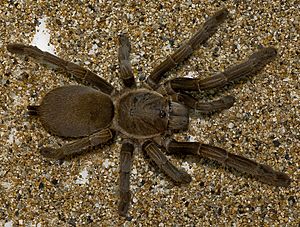Queensland whistling tarantula facts for kids
The Queensland whistling tarantula, also known as the "barking spider" or "eastern tarantula", is a type of tarantula found along the east coast of Queensland, Australia. It gets its name "whistling tarantula" because it can make a hissing sound when it feels threatened. This sound comes from the spider rubbing special bristles near its mouthparts. Its scientific name, Selenocosmia crassipes, means "fat leg" in Latin, referring to its thick front legs.
This amazing spider can grow quite large! Its legs can spread out up to 22 centimeters (about 8.7 inches). Its body, from its eyes to the end of its abdomen, is usually between 6 and 9 centimeters (about 2.4 to 3.5 inches) long. This makes it the biggest tarantula in Australia.
Quick facts for kids Queensland whistling tarantula |
|
|---|---|
 |
|
| Scientific classification | |
 |
|
| Synonyms | |
|
Contents
Meet the Whistling Tarantula
The Queensland whistling tarantula has strong, long fangs that can grow up to 1 centimeter (about 0.4 inches) long. Its body is about 6 centimeters (2.4 inches) long, but its leg span can be 16 centimeters (6.3 inches) or even larger! That's bigger than a human hand. You can often tell this spider apart because its front legs are thicker than its back legs. It's known as the largest spider in Australia.
This spider is quite shy. It usually stays close to its underground home. Female whistling tarantulas can live for a very long time, up to thirty years! Males, however, live for about eight years.
What Happens If It Bites?
A bite from an Eastern tarantula is not deadly to a human. However, it can make a person feel very sick, causing them to vomit for up to six hours. For smaller animals like a dog or a cat, the venom can be much more dangerous. It can cause death within about thirty minutes.
In 2010, a scientist was bitten by one of these spiders. Her finger became very swollen and painful. The pain and swelling spread to her hand and lower arm. Luckily, the symptoms started to get better after about 26 hours.
What Does This Spider Eat?
Even though some people call them "bird-eating spiders," these tarantulas usually don't eat birds. They are active at night and live on the ground. They mostly eat insects and other spiders. Sometimes, they also eat small animals like geckos, skinks, and frogs.
Where Do Whistling Tarantulas Live?
The Queensland whistling tarantula is found all over North Queensland. It's a burrowing spider, meaning it lives underground in tunnels. These burrows can be up to 1 meter (about 3.3 feet) deep! Sometimes, heavy rain can force them out of their homes.
Young spiders find natural hiding spots under rocks or tree roots. As they grow, adult spiders make their burrows larger, sometimes up to 2 meters (about 6.6 feet) deep. They line their tunnels with silk. They even dig a side tunnel that goes up to a special chamber with an air pocket. This air pocket is big enough to help them survive for a few days if their burrow floods.
You can find these spiders in rainforests and sheltered areas like gullies. They also live in open forests along the central coast of Queensland. They might even be found in gardens or other places with lots of plants.
Whistling Tarantulas as Pets
The Queensland whistling tarantula grows quickly and is a popular pet. However, many of these spiders are taken from the wild, sometimes illegally. This can be a problem for their natural populations.

